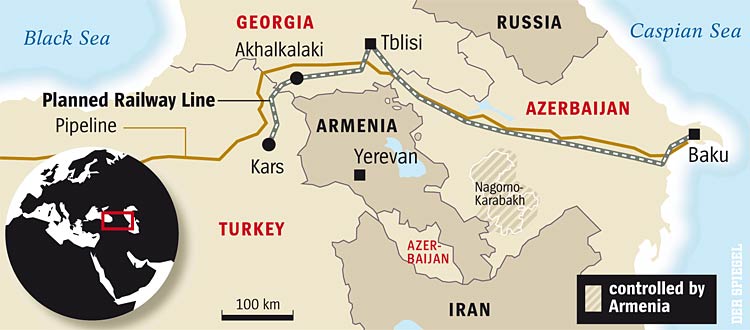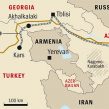
MOMENTOUS IMPLICATIONS OF AZERBAIJAN-GEORGIA-TURKEY RAILROAD (part one)
Publication: Eurasia Daily Monitor Volume: 4 Issue: 219
By:

Ignoring the anti-constitutional opposition’s calls for immediate regime change, Georgia began construction work on its section of the Baku-Tbilisi-Kars (Turkey) railroad on November 21. The railroad will connect Asia and Europe via the South Caucasus. The Georgian section is the linchpin to the entire project.
Presidents Ilham Aliyev, Mikheil Saakashvili, and Abdullah Gul attended the groundbreaking ceremony at the Marabda railroad station in southeastern Georgia and an inaugural event in Tbilisi. The three countries are carrying out this intercontinental project without any involvement by other parties or international organizations. With the European Union defaulting on its earlier-declared transit policy, and the United States neutralized on this issue by anti-Turkish and anti-Azeri lobbying in Congress, it is Azerbaijan that has taken the lead in this project, serving both regional and Western interests.
The project will link the railroads of Azerbaijan, Georgia, and Turkey by constructing missing links and upgrading old, worn-out sections in Georgia and Turkey. When complete, the railroad will link up eastward from Baku with Kazakhstan by trans-Caspian shipping lines and westward, from the undersea railroad tunnel near Istanbul to wider Europe. The project is dubbed an “Iron Silk Road.”
Mainly at Azerbaijan’s initiative, in February 2007 the three countries signed an intergovernmental agreement to carry out this project. It involves building 105 kilometers of track from scratch, including 76 kilometers in Turkey and 29 kilometers in Georgia; and totally upgrading some 190 kilometers of old dilapidated tracks in Georgia. The target date for completion is 2010.
Project costs are preliminarily estimated at $600 million, including $420 million for construction and reconstruction of those railroad sections, with the remainder to be spent on related infrastructure. The International Bank of Azerbaijan is financing most of the construction and reconstruction on Georgian territory. It has agreed to give Georgia a $200 million loan on the softest of terms: repayment in 25 years at 1% interest. Georgia will repay the loan from the revenue generated by the railroad on its territory.
Turkey is financing and building the railroad section on its territory. The Azerbaijani company Azerinshat Service will construct the Georgian section.
Cargo volume on the railroad is anticipated at 5 million tons annually in the initial stage after 2010, some 15 million tons by mid-decade, and some 30 million tons annually from 2020 onward. Passenger service is also envisaged.
This railroad will reconnect Georgia with the outside world after the Russian destruction or blockade of Georgia’s railroad outlets to Russia. The Georgian railroad’s Abkhaz section has been inoperable since the 1992-93 Russian military intervention; and other overland routes are closed since 2006 as part of Russia’s overall transport blockade.
Moreover, the new outlet to Turkey and Europe reorients Georgia’s main transport axis from the Russian to the Western direction. It “opens a window to Europe for Georgia and its citizens,” Saakashvili said at the groundbreaking event. It can also create tens of thousands of new jobs in Georgia and help revitalize the deeply impoverished, mostly Armenian-populated Javakheti area, overcoming its economic isolation.
Azerbaijan had experienced (together with Georgia) the temporary blockade of its own railroad and other transport outlets by Russia during the two Chechen wars. The railway via Georgia to Turkey and Europe will now be safe from that type of Russian action. “This railroad will make Azerbaijan and Georgia stronger and more independent,” Aliyev stated at the groundbreaking event.
For his part, Gul described this railroad as a “history-changing project,” one that ultimately links “China to London” on the shortest overland route through the South Caucasus and Turkey. Some observers anticipate that China will prefer this railroad over Russia’s Trans-Siberian for Chinese exports to this region and also to certain European destinations.
Kazakhstan is expected to use this railroad for at least 10 million tons of cargo annually for its booming exports, including oil and grain. With grain exports projected at up to 5 million tons annually, Kazakhstan is now completing construction of an 800,000-ton grain-handling terminal near Baku for storage and transfer from ships to railroad.
Through this railroad, Kazakhstan gains unprecedented, direct access to Europe on the shortest overland route. Kazakhstan will be able to shift some of its westbound cargoes into this route, away from Russian railroads. These charge extortionate rates — a long-standing grievance of Kazakhstan — in the absence of competition. The Azerbaijan-Georgia-Turkey railroad will break Russia’s monopoly on railroad transport from Kazakhstan and other Central Asian countries, just as pipelines through the South Caucasus can break the Russian monopoly on oil and gas transit from Central Asia.
(Trend, Azertaj, Civil Georgia, Messenger, Anatolia, Zaman, November 21-24; Journal of Turkish Weekly, November 23)




